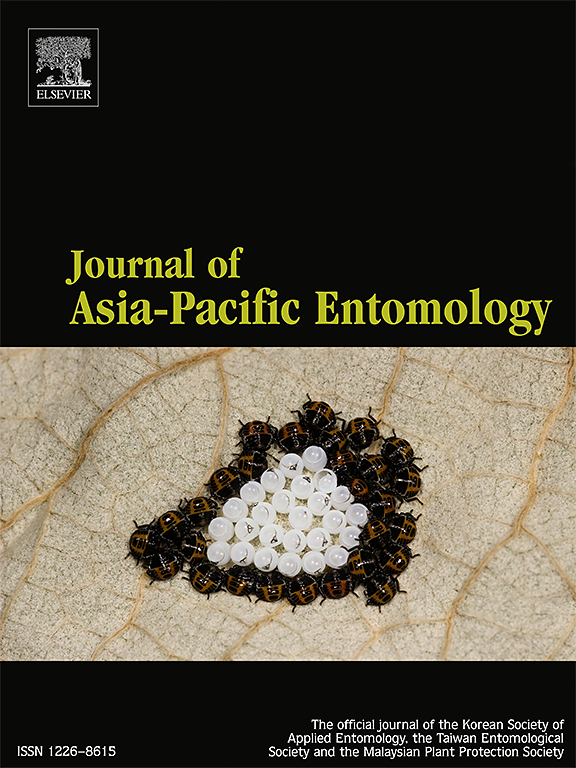Determining the variety and ages of 5th instar silkworms for a functional food production through color, phytochemicals, antioxidant activities, absorbance spectra, and gene expression analysis
IF 1.1
3区 农林科学
Q3 ENTOMOLOGY
引用次数: 0
Abstract
HongJam (HJ) is a natural food made by steaming mature silkworms, known for its health benefits. The correct type and age of silkworms are essential for its production. This study established standard operating protocols to identify silkworm varieties and ages for making steamed and freeze-dried silkworm powders (SSP) or HJ. By comparing the color of powders made from three silkworm types—White Jade (WJ), Golden-silk (GS), and Juhwang-silk—significant differences in color measurements (ΔE*ab values) were found. Silkworms of WJ and GS varieties were harvested daily from the 3rd day of the 5th instar stage to maturity, and the color of their powders was analyzed. The color differences (ΔE*ab) were smallest on the 7th day for GS-SSP and the 9th day for WJ-SSP compared to their HJ counterparts. The ΔE*ab values were the lowest on the GS-SSP produced with the 7th day of the 5th instar silkworm and the WJ-SSP produced with 9th day of the 5th instar silkworm when compared to GS- or WJ-HJ, respectively. The age of silkworms for GS-SSP/HJ production was further determined by analyzing antioxidant activity and the levels of specific plant-based compounds in their extracts. Age identification was also possible by measuring light absorption (200–800 nm) of the extracts and by studying the expression of a gene associated with mature silkworms. In summary, this study offers practical methods to determine the variety and age of silkworms for HJ production, supporting its quality control as a functional food.

通过颜色、植物化学成分、抗氧化活性、吸收光谱和基因表达分析来确定5龄蚕的品种和年龄,用于功能性食品生产
红酱(HJ)是一种天然食品,由成熟的蚕蛹蒸制而成,以其健康益处而闻名。正确的蚕的种类和年龄对它的生产至关重要。本研究建立了标准操作规程,以确定蒸蚕粉和冻干蚕粉(SSP)或HJ的品种和年龄。通过比较白玉(WJ)、金丝(GS)和菊黄丝(juhwang -silk)三种蚕制粉的颜色,发现颜色测量值(ΔE*ab值)存在显著差异。从5龄第3天开始,每天采集WJ和GS品种的家蚕至成熟,并对其粉的颜色进行分析。与HJ相比,GS-SSP和WJ-SSP在第7天和第9天的色差(ΔE*ab)最小。与GS-和WJ-HJ相比,5龄第7天产的GS- ssp和5龄第9天产的WJ-SSP的ΔE*ab值最低。通过分析蚕蛹提取物的抗氧化活性和特定植物性化合物的水平,进一步确定了蚕蛹生产GS-SSP/HJ的年龄。通过测定提取物的光吸收(200-800 nm)和研究成熟蚕相关基因的表达,也可以确定年龄。综上所述,本研究为确定生产HJ的蚕品种和年龄提供了实用的方法,为其作为功能食品的质量控制提供了支持。
本文章由计算机程序翻译,如有差异,请以英文原文为准。
求助全文
约1分钟内获得全文
求助全文
来源期刊

Journal of Asia-pacific Entomology
Agricultural and Biological Sciences-Insect Science
CiteScore
2.70
自引率
6.70%
发文量
152
审稿时长
69 days
期刊介绍:
The journal publishes original research papers, review articles and short communications in the basic and applied area concerning insects, mites or other arthropods and nematodes of economic importance in agriculture, forestry, industry, human and animal health, and natural resource and environment management, and is the official journal of the Korean Society of Applied Entomology and the Taiwan Entomological Society.
 求助内容:
求助内容: 应助结果提醒方式:
应助结果提醒方式:


